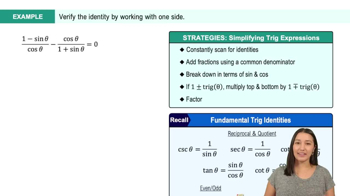Table of contents
- 0. Review of College Algebra4h 43m
- 1. Measuring Angles39m
- 2. Trigonometric Functions on Right Triangles2h 5m
- 3. Unit Circle1h 19m
- 4. Graphing Trigonometric Functions1h 19m
- 5. Inverse Trigonometric Functions and Basic Trigonometric Equations1h 41m
- 6. Trigonometric Identities and More Equations2h 34m
- 7. Non-Right Triangles1h 38m
- 8. Vectors2h 25m
- 9. Polar Equations2h 5m
- 10. Parametric Equations1h 6m
- 11. Graphing Complex Numbers1h 7m
6. Trigonometric Identities and More Equations
Introduction to Trigonometric Identities
Problem 47
Textbook Question
Textbook QuestionIn Exercises 47–54, use the figures to find the exact value of each trigonometric function. θ sin ------- 2
 Verified Solution
Verified SolutionThis video solution was recommended by our tutors as helpful for the problem above
Video duration:
3mPlay a video:
Was this helpful?
Key Concepts
Here are the essential concepts you must grasp in order to answer the question correctly.
Trigonometric Functions
Trigonometric functions, such as sine, cosine, and tangent, relate the angles of a triangle to the lengths of its sides. The sine function, for example, is defined as the ratio of the length of the opposite side to the hypotenuse in a right triangle. Understanding these functions is essential for solving problems involving angles and distances.
Recommended video:

Introduction to Trigonometric Functions
Unit Circle
The unit circle is a circle with a radius of one centered at the origin of a coordinate plane. It provides a geometric representation of the trigonometric functions, where the x-coordinate corresponds to the cosine of an angle and the y-coordinate corresponds to the sine. Familiarity with the unit circle helps in determining the exact values of trigonometric functions for common angles.
Recommended video:

Introduction to the Unit Circle
Exact Values of Trigonometric Functions
Exact values of trigonometric functions refer to the precise values of sine, cosine, and tangent for specific angles, often expressed in terms of square roots. For example, sin(30°) equals 1/2, and cos(45°) equals √2/2. Knowing these exact values is crucial for solving trigonometric equations and simplifying expressions without relying on calculators.
Recommended video:

Introduction to Trigonometric Functions

 6:19m
6:19mWatch next
Master Even and Odd Identities with a bite sized video explanation from Callie Rethman
Start learningRelated Videos
Related Practice
















